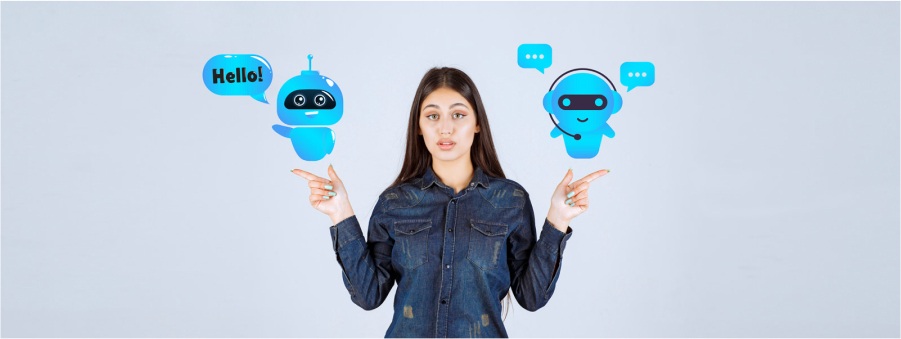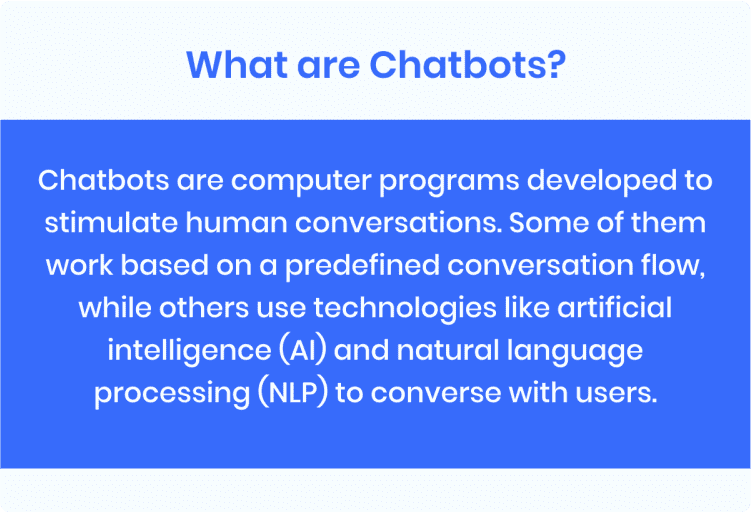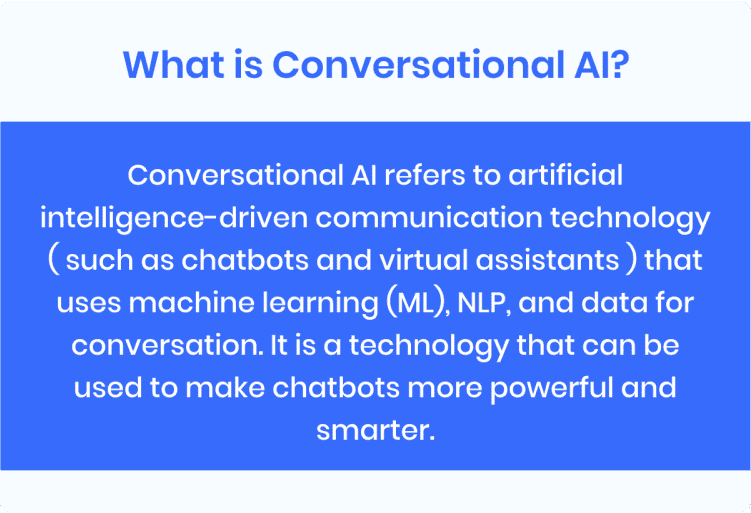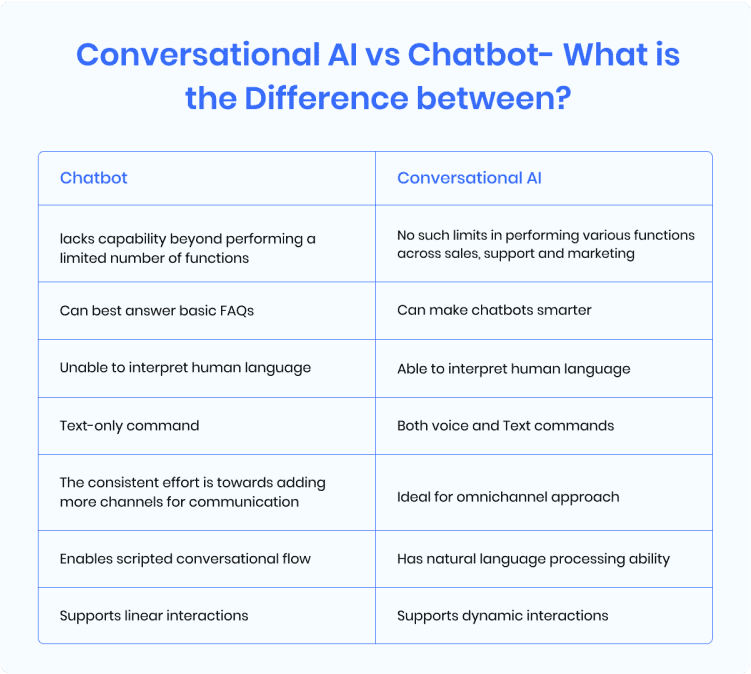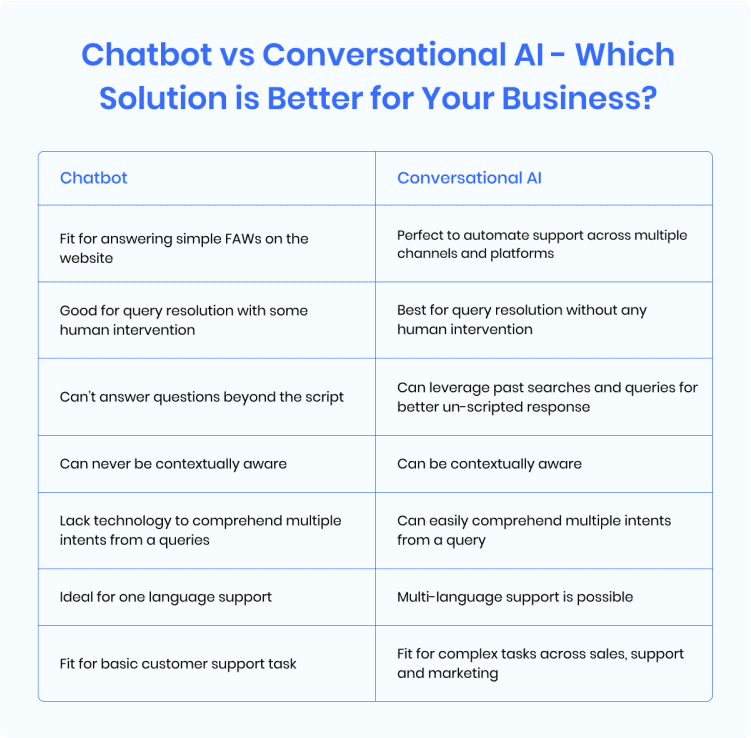Most businesses now realize the value of delivering improved experiences to customers. They also understand the huge role played by technologies like chatbots and conversational AI in achieving that goal.
It’s therefore obvious to see a spike in the usage and implementation of chatbots and conversational AI. At the same time, however, there also appears some confusion in regard to various aspects of both technologies, particularly given how many consider both to be the same, which is not the case.
In fact, a lot of people use the word “chatbots” and “conversational AI” interchangeably as if both these technologies are synonymous. Well, conversational AI vs chatbot is a topic something that is generating a lot of debate across discussion boards for lack of clarity on their roles and scope.
However, there are some marked differences between these advanced technologies, even if they serve entirely the same purposes across sales, support, and marketing. Despite the differences, both technologies have the potential to transform the way customer service is delivered, which can ultimately have a big impact on the bottom line of a business.
However, as a business leader, you should differentiate between the two at the earliest so that you can be sure which of the two can best help optimize processes and improve customer experiences (CX).
In this blog, we will discuss in detail all the differences between a chatbot and a conversational AI technology and also show examples from across industries to ensure absolute clarity on the subject.
What are Chatbots?
Chatbots are computer programs developed to stimulate human conversations. They are a kind of machine that can chat. And this chatting ability is the reason a chatbot can be used across marketing, sales, and support for creating better experiences for customers anytime.
While some chatbots work based on a predefined conversation flow, others use technologies like artificial intelligence (AI) and natural language processing (NLP) to converse with users. Chatbots are often so advanced that they can easily decipher user questions and offer automated responses in real time. They can handle full conversations around 69% of the time.
More so, chatbots can either be rule-based or AI-based and the latter are more advanced as they do not require pre-scripted rules or questions for sending responses. More so, AI-based chatbots are programmed to deviate from the script and handle queries of any complexity.
What is Conversational AI?
Conversational AI refers to artificial intelligence-driven communication technology ( such as chatbots and virtual assistants ) that uses machine learning (ML), NLP, and data for conversation. It is advanced enough to recognize vocal and text inputs and mimic human interactions to assist conversational flow.
Similarly, conversational AI is a technology that can be used to make chatbots more powerful and smarter. It’s a technology that can recognize and respond to text and speech inputs easily, therefore enabling interactions with customers in a human-like manner. Maybe that’s why 23% of customer service companies use AI chatbots for better responses.
When conversational AI technology is used, interactions can happen through a chatbot in a messaging channel or through a voice assistant over the phone. Unlike chatbots, it can determine user intent and also easily understand human language.
Conversational AI vs Chatbot- What is the Difference between?
From the above, it’s amply clear that conversational AI is a more powerful technology compared to chatbots. In fact, we have learned how a chatbot needs conversational AI technology to act smarter and become more intelligent. However, we should note that not all chatbots use conversational AI technology so not all will be powerful.
There are more differences between a chatbot and conversational AI and some of them include –
- Limitations in functionality – A conventional chatbot lacks capability beyond performing a limited number of functions. In most cases, its ability stretches to answering basic FAQs. On the other hand, conversational AI is a technology that can boost a chatbot’s ability manifold and make it easily understand and interpret human language.
- Text-only command vs Voice and text commands – While a chatbot is capable of text-only commands ( inputs & outputs ), conversational AI can go a step further and enable both, voice as well as text commands at the same time.
- Single channel vs Omnichannel – Most chatbots are limited to being used as a chat interface only and this makes it fit for a single channel alone. On the other hand, conversational AI can enable omnichannel communication by being deployed across websites, voice assistants, etc.
- Scripted vs natural language processing – Since chatbot is basic in technology it can only enable scripted conversational flow based on pre-defined rules. And when there is conversational AI, it can come with the ability of natural language processing, therefore being easily able to understand and contextualize conversations.
- Linear vs dynamic interactions – A chabot can best support linear interactions whereas a conversational AI can go steps up and enable non-linear and dynamic interactions. For that reason, AI-enabled bots are best suited for customer support tasks.
- Navigation vs Dialogue – Compared to chatbots which support navigation, conversational AI is obviously more advanced and can support the dialogue of any complexity.
Chatbot vs Conversational AI – Which Solution is Better for Your Business?
As a business, whether you should go with a chatbot or conversational AI technology entirely depends on your goals and requirements. But there is no denying that conversational AI is far better technology than a traditional chatbot. Despite that, there are certain processes and tasks where a bot would seem more suitable and vice versa.
Parameters are many to choose from when you want to decide whether to take the help of a chatbot or conversational AI.
- A traditional chatbot would be perfect when your business needs something that can help answer simple FAQs on the website and take some load off the support team.
- Conversational AI would be the right choice when your business needs to automate support across multiple channels and platforms using both text and voice.
- Basic chatbots may not be the right fit when your topmost priority is to increase user engagement and boost user satisfaction across stages of the customer journey.
- Conversational AI is the best fit when your focus is on query resolution with zero or minimum human intervention.
- Chatbots can learn on their own and even won’t answer questions that are not already incorporated whereas AI can go beyond the script and react according to past queries and searches.
- Conversational AI can be contextually aware which makes them understand the queries better and respond based on past data and searches. All this makes it offer the right answer which can prove valuable for customer service.
- Conversational AI platforms are powerful with the ability to comprehend multiple intents from a single question whereas a rule-based chatbot can’t do that. This is why e-commerce sites or websites that are into sales prefer a chatbot with AI capabilities to process customer queries effectively.
- With chatbots, users can not give voice commands, and neither can they choose more than one language for queries. No such limitations exist with conversational AI technology where users are free to choose any language and voice command.
Examples of AI Chatbot Uses Across Industries
Chatbots have become a key tool across industries for customer engagement, customer satisfaction, and conversions. They can serve a variety of purposes across processes, therefore extending their usages as wide as the airline industry, financial services, banking, pharma, etc.
Some of the top examples of chatbot use across industries include –
BB Chatbot for KLM Royal Dutch Airlines
KLM Airlines is a good example of how to use a chatbot to simplify travel plans for users and also streamline procedures for businesses. The chatbot named BB will be accessible 24×7, can support multiple languages, and provide faster responses. Using the chatbot, the airline is able to handle hundreds of travel queries efficiently, offer all the booking information with a click, and make customer support as effortless as it could get.
H&M Fashion Chatbot
Some of the top luxury brands in the world use chatbots to scale shopping services and provide great experiences to buyers. H&M is a good example, which is also a global fashion brand, in how to use a chatbot to successfully engage millennials and Gen Z customers and guide them through myriad outfit possibilities. The use of a chatbot has helped the brand increase sales and market its products more effectively.
Domino’s Messenger Bot
Thanks to chatbots, customers can now order food without making a phone call. All they need to do is click a few buttons and choose what they want. Domino’s messenger bot is a good example of how to make the best of chatbot technology and ensure amazing service to customers. Since this chatbot lives in Facebook Messenger, customers will have the flexibility to order from different devices. More so, the chatbot can also track previous purchases and make the entire food ordering procedure as smooth as it can get.
EVA for HDFC Bank
When it comes to the chatbot in banking, there can’t be a better example than EVA by HDFC. It’s an AI-powered bot in the true sense that uses Natural Language Processing (NLP) and makes support as fast and effortless as it can get.
EVA can converse with users, answer queries quickly and offer accurate responses most of the time. Ever since this bank has started using EVA, its customer support has improved manifold and more queries handled than ever before.
Power Your Business Ahead with REVE’s AI-driven Chatbot
Rule-based chatbots have some limitations and they are surely not the best option when a business thinks of catering to modern customers and needs.
We, at REVE Chat, are aware of the shortcomings that scripted chatbots can have and therefore help businesses easily design the best chatbot they can.
Using our platform, it’s quite simple to design an AI-powered chatbot in quick time, and that too, without writing a line of code.
The bot can be customized to meet the specific needs of the business whether in support, sales, or conversion.
More so, bots are not the only engagement tools that are available on this platform you can also get other ones as well, including co-browsing software and video software.
What’s more, you can combine the live chat software with the chatbot and ensure hybrid support to users across the journey with your brand.
Design a Conversational AI Chatbot with REVE and Grow Your Business
A business can definitely excel to new heights when it has the best tools at its disposal for executing tasks across various departments.
Having a conversational AI chatbot thus becomes important when the main focus of a business is on customer engagement and experience.
With REVE Chat, you can start a free trial of a chatbot and other support tools and see how they would fit into the specific needs of your business.
So, take the right step ahead and get a chatbot that can serve all your business needs as perfectly as it can be.
